
Huntsman spiders, members of the family Sparassidae, are known by this name because of their speed and mode of hunting. They are also called giant crab spiders because of their size and appearance. Larger species sometimes are referred to as wood spiders, because of their preference for woody places. In southern Africa the genus Palystes are known as rain spiders or lizard-eating spiders.. Commonly, they are confused with baboon spiders from the Mygalomorphae infraorder, which are not closely related.

Wasps in the family Pompilidae are commonly called spider wasps, spider-hunting wasps, or pompilid wasps. The family is cosmopolitan, with some 5,000 species in six subfamilies. Nearly all species are solitary, and most capture and paralyze prey, though members of the subfamily Ceropalinae are kleptoparasites of other pompilids, or ectoparasitoids of living spiders.

A spinneret is a silk-spinning organ of a spider or the larva of an insect. Some adult insects also have spinnerets, such as those borne on the forelegs of Embioptera. Spinnerets are usually on the underside of a spider's opisthosoma, and are typically segmented. While most spiders have six spinnerets, some have two, four, or eight. They can move both independently and in concert.

Urticating hairs or urticating bristles are one of the primary defense mechanisms used by numerous plants, almost all New World tarantulas, and various lepidopteran caterpillars. Urtica is Latin for "nettle", and bristles that urticate are characteristic of this type of plant, and many other plants in several families. This term also refers to certain types of barbed bristles that cover the dorsal and posterior surface of a tarantula's or caterpillar's abdomen. Many tarantula species eject bristles from their abdomens, directing them toward potential attackers. These bristles can embed themselves in the other animal's skin or eyes, causing physical irritation, usually to great discomfort. The term "hairs" is technically a misnomer, as only mammals possess true hairs. The scientific term for plant hairs is trichomes.

Mantispidae, known commonly as mantidflies, mantispids, mantid lacewings, mantisflies or mantis-flies, is a family of small to moderate-sized insects in the order Neuroptera. There are many genera with around 400 species worldwide, especially in the tropics and subtropics. Only five species of Mantispa occur in Europe. As their names suggest, members of the group possess raptorial forelimbs similar to those of the praying mantis, a case of convergent evolution.

Chiasmocleis ventrimaculata, also known as the dotted humming frog, is a species of frog in the family Microhylidae. It is found in Bolivia, Brazil, Colombia, Ecuador, and Peru. Its natural habitats are subtropical or tropical moist lowland forests, swamps, and intermittent freshwater marshes.
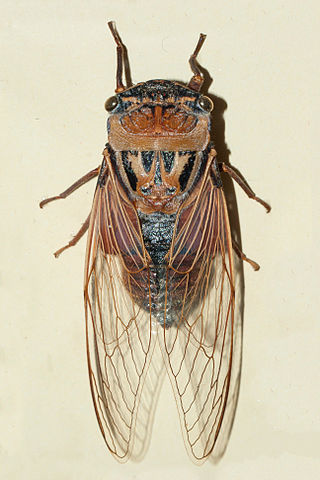
Thopha saccata, the double drummer, is the largest Australian species of cicada and reputedly the loudest insect in the world. Documented by the Danish zoologist Johan Christian Fabricius in 1803, it was the first described and named cicada native to Australia. Its common name comes from the large dark red-brown sac-like pockets that the adult male has on each side of its abdomen—the "double drums"—that are used to amplify the sound it produces.
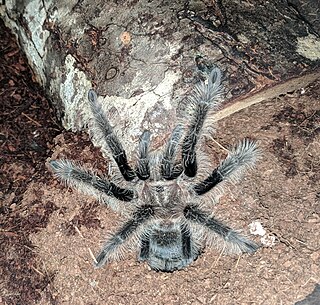
Tliltocatl albopilosus is a species of tarantula, also known as the curlyhair tarantula. The species' native range is Nicaragua and Costa Rica. They are largely terrestrial, opportunistically burrowing spiders.

Tarantulas comprise a group of large and often hairy spiders of the family Theraphosidae. As of December 2023, 1,100 species have been identified, with 166 genera. The term "tarantula" is usually used to describe members of the family Theraphosidae, although many other members of the same infraorder (Mygalomorphae) are commonly referred to as "tarantulas" or "false tarantulas". Some of the more common species have become popular in the exotic pet trade. Many New World species kept as pets have setae known as urticating hairs that can cause irritation to the skin, and in extreme cases, cause damage to the eyes.

The Aphonopelma hentzi, also known as Texas brown tarantula, Oklahoma brown tarantula, or Missouri tarantula, is one of the most common species of tarantula living in the Southern United States today. Texas brown tarantulas can grow to leg spans in excess of 10 cm (4 in), and weigh more than 85 g (3 oz) as adults. Their bodies are dark brown, though shades may vary between individual tarantulas. The colors are more distinct after a molt, as with many arthropods.

Psalmopoeus cambridgei, the Trinidad chevron tarantula, is a species of spider in the family Theraphosidae, endemic to Trinidad. Its venom is the source of psalmotoxin and vanillotoxin which are classified as inhibitor cystine knot proteins. Psalmotoxin may be of therapeutic use in patients with a stroke.
Cneoglossidae is a family of beetles in the superfamily Byrrhoidea, containing nine described species in a single genus, Cneoglossa, which are native to the Neotropics from Mexico to Brazil. The larvae develop inside rotting submerged branches found in small fast flowing shallow streams.

Aphonopelma anax, commonly known as the Texas tan tarantula, is a species of spider belonging to the family Theraphosidae native to southern Texas and northern Mexico.

Hemerobius is a genus of lacewings in the family Hemerobiidae. It is found throughout Europe and North America. Like most lacewings, both the larvae and adults are predatory, primarily eating acarines, scale insects, psyllids, aphids, thrips, and the eggs of lepidopterans and whiteflies.
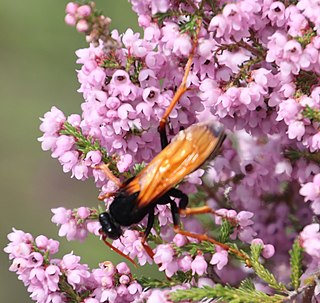
Hemipepsis is a genus of large pepsine spider wasps found throughout the tropics. They are commonly known as tarantula hawks. Hemipepsis wasps are morphologically similar to the related genera Pepsis and Entypus, but distinguishable by the pattern of wing venation. In South Africa 18 plant species from three plant families, the Apocynaceae, Orchidaceae, and Asparagaceae subfamily Scilloideae are pollinated exclusively by Hemipepsis wasps.

The Thynnidae are a family of large, solitary wasps whose larvae are almost universally parasitoids of various beetle larvae, especially those in the superfamily Scarabaeoidea. Until recently, the constituents of this family were classified in the family Tiphiidae, but multiple studies have independently confirmed that thynnids are a separate lineage.
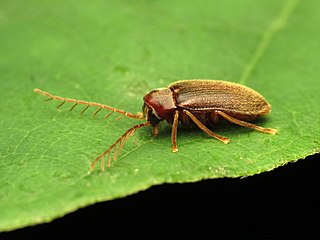
Ptilodactylidae is a family of beetles belonging to the Elateriformia. There around 500 extant species in 35 genera. They are generally associated with riparian and aquatic habitats. The larvae generally live associated with rotting wood or vegetation, or within gravel and detritus on the edge of water bodies. The larvae of some species feed on submerged rotting wood or on plant roots, while the adults of some species are known to feed on fungus with modified brush-like maxillae.
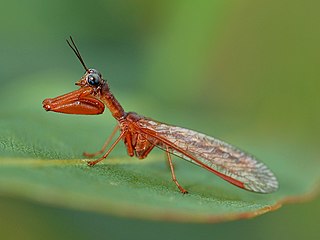
Mantispinae is a subfamily of mantidflies in the family Mantispidae. There are at least 30 genera and 310 described species in Mantispinae.

Perla is a genus of common stoneflies in the family Perlidae. There are at least 30 described species in Perla.

Monocentropus balfouri is a tarantula in the Monocentropus genus, it was first described by Reginald Innes Pocock in 1897. This tarantula is also called Socotra Island Blue Baboon Tarantula, usually shortened to Blue Baboon Tarantula. This spider is named after its collector Isaac Bayley Balfour. It is found in Socotra Island, hence the common name. This tarantula is terrestrial and an opportunistic burrower. Like many tarantulas, M. balfouri can be kept as a pet, although it is not a beginner species.



















